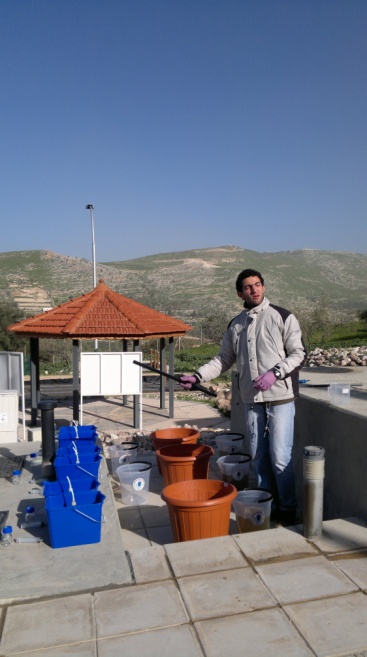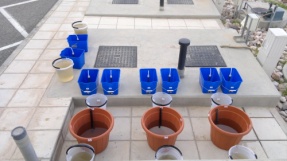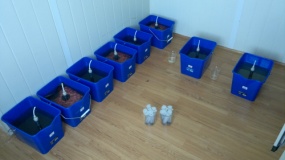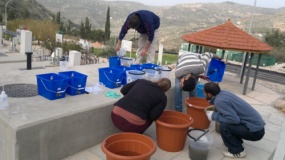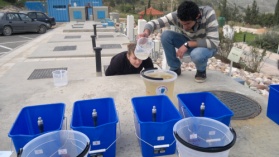Research Activities
SMART project- demonstration, research and test site is a place which accommodates variety of technologies that needs to be calibrated and adapted to local conditions in order to produce effluents that comply with the Jordanian Standards 893/2006. Doctorate and Master's research works and dissertations have been conducted. The aim is to develop efficient systems that provide high quality effluent suitable for irrigation and reuse.
Optimization of recirculating vertical flow constructed wetland for total nitrogen removal
Abstract
Jordan National Water Strategy emphasizes the need for increased use of reclaimed water in agriculture. Therefore, effective wastewater treatment systems including decentralized facilities are needed. Among different decentralized wastewater systems, constructed wetland (CW) was found to be an eco-technology which is robust, reliable and cost effective as well as suitable for the treatment of domestic wastewater. Vertical flow constructed wetland VFF was proven to be the most suitable eco-system for removal of carbonaceous content of domestic wastewater. However, removal of nitrogenous contents was usually limited. Recirculating vertical flow filter is a novel modification of the VFF allowing higher denitrification by circulating the effluent back into the circulation tank where it is mixed with raw wastewater. A recirculating vertical-flow constructed wetland (R-VF) located at SMART demonstration site at Fuhais has been put under operation since June 2009. The system was designed for the treatment of domestic wastewater received from the nearby centralized wastewater treatment plant with a mean hydraulic loading rate of 108 L/m².d and a recirculation ratio of 3:1. The system exhibited a moderate total nitrogen removal (52%), where nitrate concentration represented about 74% of total nitrogen concentration of the VFF effluent. This indicates that the total nitrogen removal is limited by denitrification process implying that the system is not capable of reaching category-A of the JS 893/2006 where TN and NO3-N concentrations are 45 mg/L and 30 mg/L respectively. However, the mean removal efficiencies for BOD5, NH4-N, and TSS were found to be 93.7%, 98.2%, and 96.1% respectively. Microcosms experiments were carried out in the laboratories of the SMART demonstration site in order to investigate the effect of available carbon source and media inclusion on TN reduction. The results have shown that inclusion of attached growth media resulted in enhanced denitrification. Treatment of the mixture of raw wastewater with R-VFW effluent after 48 hours contact time resulted in denitrification efficiency of 83% in the suspended growth microcosm and 99.5% in the attached growth, where the majority of NO3-N removal was achieved in the first 24 hours. It has been shown, that denitrification efficiency was increased from 36% to 93% and from 31% to 88% by inclusion of attached growth media in the microcosms containing septic tank effluents after one day and two days of hydraulic retention time, respectively. The outcome of the microcosms experiment highlights that the lower the degree of pretreatment of wastewater (higher level of organic content) the greater the rate of NO3-N reduction
Optimized Operation of Constructed Wetlands Used in Decentralized Wastewater Treatment
Abstract
Jordan National Water Strategy emphasizes the need for increased use of reclaimed water in agriculture. Therefore, effective wastewater treatment systems including decentralized facilities are needed. Among different decentralized wastewater systems, constructed wetland (CW) was found to be an eco-technology which is robust, reliable and cost effective as well as suitable for the treatment of domestic wastewater. Vertical flow constructed wetland VFF was proven to be the most suitable eco-system for removal of carbonaceous content of domestic wastewater. However, removal of nitrogenous contents was usually limited. Recirculating vertical flow filter is a novel modification of the VFF allowing higher denitrification by circulating the effluent back into the circulation tank where it is mixed with raw wastewater. A recirculating vertical-flow constructed wetland (R-VF) located at SMART demonstration site at Fuhais has been put under operation since June 2009. The system was designed for the treatment of domestic wastewater received from the nearby centralized wastewater treatment plant with a mean hydraulic loading rate of 108 L/m².d and a recirculation ratio of 3:1. The system exhibited a moderate total nitrogen removal (52%), where nitrate concentration represented about 74% of total nitrogen concentration of the VFF effluent. This indicates that the total nitrogen removal is limited by denitrification process implying that the system is not capable of reaching category-A of the JS 893/2006 where TN and NO3-N concentrations are 45 mg/L and 30 mg/L respectively. However, the mean removal efficiencies for BOD5, NH4-N, and TSS were found to be 93.7%, 98.2%, and 96.1% respectively. Microcosms experiments were carried out in the laboratories of the SMART demonstration site in order to investigate the effect of available carbon source and media inclusion on TN reduction. The results have shown that inclusion of attached growth media resulted in enhanced denitrification. Treatment of the mixture of raw wastewater with R-VFW effluent after 48 hours contact time resulted in denitrification efficiency of 83% in the suspended growth microcosm and 99.5% in the attached growth, where the majority of NO3-N removal was achieved in the first 24 hours. It has been shown, that denitrification efficiency was increased from 36% to 93% and from 31% to 88% by inclusion of attached growth media in the microcosms containing septic tank effluents after one day and two days of hydraulic retention time, respectively. The outcome of the microcosms experiment highlights that the lower the degree of pretreatment of wastewater (higher level of organic content) the greater the rate of NO3-N reduction
Wiederinbetriebnahme, Betrieb und Optimierung einer MBR-Anlage in Containerbauweise am Standort Fuheis in Jordanien (German) - Completed
In Zusammenarbeit mit dem IWRM und dem BMBF und deren Unterstützung durch mehrere Organisationen und Betriebe, die auf deutschem und internationalem Raum vertreten sind, wird das Forschungsprojekt SMART durchgeführt. Diese Arbeit wurde an der SMART-Site am Standort Fuheis in Jordanien angefertigt. Inhaltlich wird sich im Folgenden mit der Wiederinbetriebnahme, dem Betrieb und der Betreuung einer MBR-Anlage der Firma HUBER SE beschäftigt. Ziel ist es hierbei, das kommunale Abwasser der Stadt Fuheis als wertvolle Resource zu betrachten und es mithilfe moderner Membrantechnik auf möglichst kleinem Raum und unter Einhaltung des jordanischen Wasserstandards aufzubereiten. Als weiterer Verfahrensschritt wird die Wiederverwendung des gereinigten Permeates zur Grundwasseranreicherung im Jordantal betrachtet. Die betreute MBR-Anlage wurde bereits von mehreren Diplomanten und Bacheloranten in Deutschland betreut. Nach positiven Ergebnissen auf deutscher Seite wurde sie, nach Reinigung und Wartung auf dem Betriebsgelände der Firma HUBER SE, nach Jordanien verschifft. Seit der Inbetriebnahme im März 2012 lieferte die Membrananlage gute Ergebnisse. Aufgrund der klimatischen Verhältnisse in Jordanien und der hohen Temperaturen kam es zur Beschädigung eines elektrischen Bauteils der Steuerung. Folge dessen war eine Stilllegung der MBR-Anlage. Nach erneuter Inbetriebnahme wurde durch ständige Analytik und Beobachtung verschiedenster, im weiterem Verlauf genauer erläuterte Parameter, eine Optimierung durchgeführt und ein stabiler Prozess bereitgestellt. Während dieser Optimierungsphase wurden stets Mitarbeiter der Universität Al-Balqa eingewiesen und mit der Membrantechnik vertraut gemacht. Diese Mitarbeiter sollten die Arbeiten an der MBR-Anlage zukünftig in Zusammenarbeit mit der Universität Al-Balqa durchführen und diese auf der SMART-Site betreuen. Aufgrund der Versorgungsprobleme mit Storm und Abwasser wurde der weitere Betrieb eingestellt.
- PhD research work: Nitrogen and E.coli removal in vertical flow constructed wetland designs and suitability of treated wastewater for use in subsurface irrigation in Jordan - Ongoing

